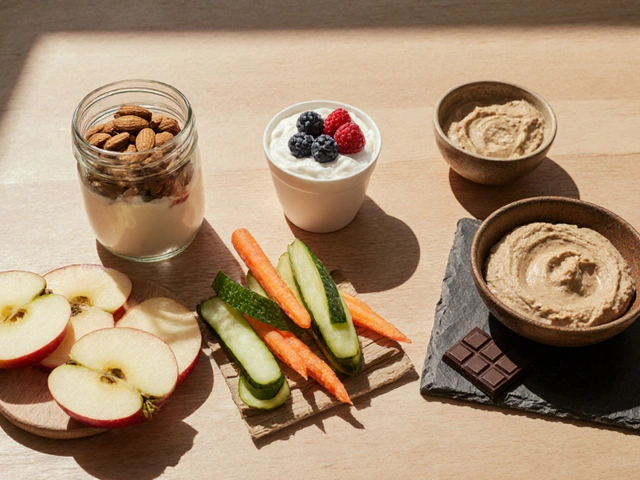
Health goals might sound like a big deal, but they don't have to be. One surprising fact? Small changes can make a huge difference. Seriously! It's all about getting the plan right and making it work for you.
First thing's first: lay a solid foundation. Think about why you're doing this. Want to feel more energetic? Maybe you're aiming to climb those pesky stairs without gasping for air. Whatever the reason, writing it down can really help nail it in your mind.
Next, it's time to set goals – but not just any goals. We're talking about ones that you can actually reach without breaking a sweat, literally and figuratively. The secret? Keep them SMART (Specific, Measurable, Achievable, Relevant, Time-bound).
Laying the Foundation
Alright, let's get down to the basics of setting up your health goals. Before you dive into the action, it's essential to get your priorities clear. Think about your motivations and what you're hoping to achieve. This isn't just about looking good but feeling good too.
Understanding Your Why
Why do you want to embark on this wellness journey? Is it to boost your energy, manage stress better, or maybe it's for overall well-being? Whatever your reason, knowing your 'why' can provide a strong foundation. A Harvard Health study even mentions that intrinsic motivation can significantly improve your chances of sticking to your goals.
"The motivation that leads to long-term change is a deeply personal choice, rooted in one's personal values and desires." - Dr. John Ratey
Getting Real with Your Health
Before setting any goals, assess where you stand health-wise. Schedule a check-up, know your numbers like blood pressure and cholesterol, and understand any family health risks. Your doctor's input can be crucial in shaping realistic goals.
Setting a Baseline
Keeping track of your current habits is a great way to start. You might be surprised at the little things you do every day. Use a simple notebook or an app to jot down your eating habits, any exercises you do, and your sleep patterns for a week. This baseline helps you see where changes might be needed.
Making Your Space Supportive
Your environment can have a big impact on your personal wellness. Try to arrange your home space to make healthy choices easier. Stock the pantry with nutritious snacks or place a yoga mat where you can see it. This way, you're pretty much laying cues around to help you stick to your plan.
Small Steps, Big Changes
| Activity | Average Calorie Burn (30 min) |
|---|---|
| Walking | 150 calories |
| Biking | 250 calories |
| Yoga | 100 calories |
Remember, even small steps can add up. It's the daily choices that compound over time, bringing about the changes you seek. Whether it's taking a walk, biking, or doing yoga, every bit counts.
Setting Effective Goals
Alright, so you've decided to take charge of your wellness journey, but you're wondering how to make your health goals stick, right? Let’s break it down.
Start With Clear Intentions
Give your goals a purpose. Ask yourself why you're pursuing a healthier lifestyle. Whether it's to feel more energetic or to achieve a personal best in a local marathon, knowing your 'why' keeps you grounded.
Embrace SMART Goals
Ever heard of SMART goals? They're about six times more likely to lead to success compared to vague objectives. Here’s how:
- Specific: Instead of “I want to be healthier,” try “I want to eat two servings of vegetables with each meal.”
- Measurable: Want to get stronger? Say, “I'll lift weights twice a week,” so you can track progress.
- Achievable: Don't set yourself up for failure with unachievable goals like running a marathon without training. Start with a 5K.
- Relevant: Align goals with what matters to you. If mental clarity is a priority, focus on mindfulness exercises.
- Time-bound: Give yourself a deadline to stay motivated, like trying out a new healthy recipe every week for a month.
Break Goals into Bite-Sized Pieces
Sometimes, the journey feels too big. Break it down. If you're aiming to lose 20 pounds, focus first on shedding the first five. Celebrate those little victories!
Track and Adjust
Keep tabs on progress with apps or journals, and don't sweat it if things don’t go perfectly. Adapt your approach as you learn what works.
Remember, enough sleep, physical activity, and proper nutrition make goals more achievable, but they also improve overall health. It's a win-win! And for those who love data, did you know a study I read states people who track their goals are 42% more likely to achieve them? That's motivation right there.
By setting effective goals, you're carving a path to not only hitting those targets but truly enjoying the journey to better health.

Staying on Track
Alright, you've set your health goals and made a plan. But how do you stick to it? Staying on track isn't just about willpower; it's about making the journey as smooth as possible. Heck, even the best-laid plans can go off the rails, but don't sweat it. It's perfectly normal to have ups and downs.
First up, track your progress. And I don't just mean stepping on the scale every morning. Think broader. Use an app to log your meals, workouts, or even your moods. Modern apps can give you graphs that show how far you’ve come. Seeing those bars climb is super motivating.
Build Consistency
Consistency is your best buddy on this ride. Create a routine that fits into your lifestyle like a glove. Hate mornings? Then don't force a 6 a.m. workout. Do it after work, when you feel more alive. Your wellness journey has to mesh with how you live, or it’s just not gonna stick.
Find Your Support System
Nobody said you have to do this alone. A support crew can make a huge difference. This could be friends, family, or even an online community that shares your wellness goals. They can keep you accountable and offer a fresh perspective.
If you slip, learn from it. Let's be honest, we all have cheat days or miss our exercise plan sometimes. Use those moments as learning opportunities, not as reasons to quit.
Reward Yourself
Don’t forget to celebrate wins, big or small. Hit a milestone? Treat yourself – maybe a new book or a fun outing. Rewards give you tiny bursts of gratification without derailing your progress. They signal your brain that you're doing well and help maintain the momentum.
In a nutshell, staying on track is all about adapting your environment to keep those health goals within reach. Don't be too hard on yourself, and remember, progress, not perfection, is the name of the game.
Evaluating Progress
Once you've kickstarted your wellness journey, it's crucial to keep tabs on how you're doing. It's not just about checking a box; it's about seeing how far you've come and tweaking what doesn't work.
Keep Track of Your Achievements
Start by jotting things down. Whether you use a journal or a fancy app, just make sure you're making notes. Did you hit the gym twice this week instead of loafing on the couch? Write it down! Seeing your past wins can boost your motivation.
Check Your Measurements
Numbers can help paint a clear picture of progress. Grab that tape measure or weighing scale. Keeping track of body measurements or weight can show tangible results of your health goals. But remember, it's not all about the scales—overall wellness is key!
Adjust and Adapt
As life changes, your goals might need a little tweaking too. Maybe you started out wanting to run a 5k, but now you're more into yoga and discovering new recipes for healthier eating. Go with the flow and keep your health goals in line with what actually makes you happy and healthy.
- Set regular check-ins with yourself. A quick monthly review can work wonders!
- Invite a buddy to join in. A fresh perspective can sometimes help spot what you might miss.
- Celebrate your wins—both big and small. Reward yourself for a month of consistency!
Remember, the journey is just as important as the destination. You'll have setbacks and breakthroughs, both of which are part of the ride. So keep cheering yourself on and the rest will follow.





